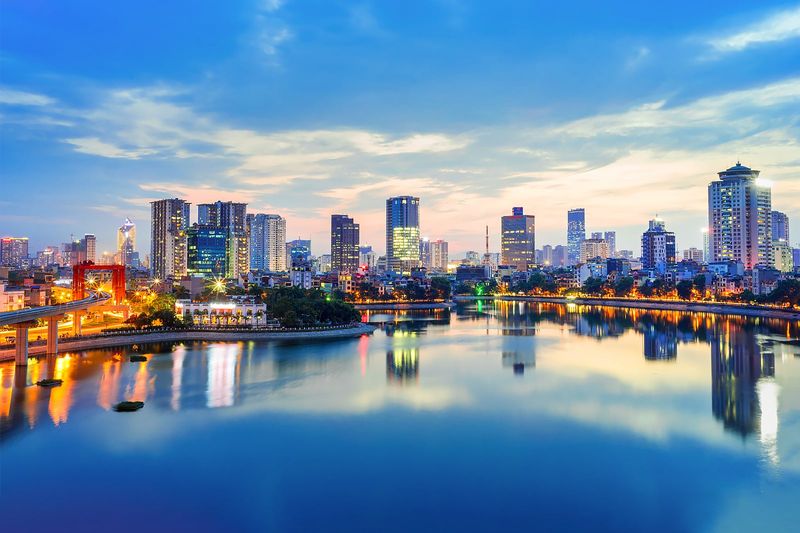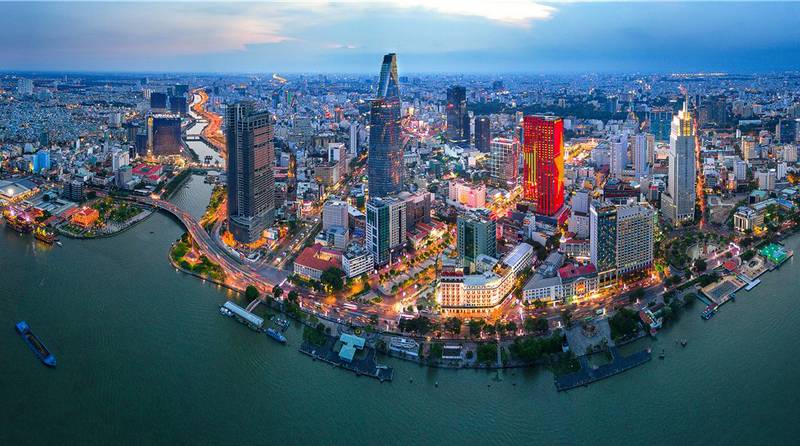Vietnam is a land of contrasts—where ancient temples sit beside modern cities, lush mountains tower over terraced fields, and unspoiled beaches stretch alongside bustling towns. Whether you’re a nature lover, cultural enthusiast, or food explorer, this Southeast Asian gem offers something for every kind of traveler.
In this guide, we’ll take you through the 12 best places to visit in Vietnam, based on popular demand, local insight, and the latest travel trends. From the vibrant chaos of Hanoi to the otherworldly caves of Phong Nha, this is your ultimate itinerary planner for an unforgettable Vietnam journey.
Hanoi: the vibrant northern capital
As the capital of Vietnam, Hanoi is often the first stop for international travelers—and it rarely disappoints. The city is a captivating mix of ancient charm and modern hustle. Wander through the Old Quarter, where narrow streets bustle with vendors, scooters, and vibrant life. Don’t miss a stroll around Hoan Kiem Lake or a stop at the Temple of Literature, Vietnam’s first university.

Why visit Hanoi?
- Cultural and historical depth (museums, French colonial architecture)
- Street food heaven: try pho bo, bun cha, and the iconic egg coffee
- Lively nightlife and café culture
Travel tips:
- Best time to visit: October to April (cool and dry)
- Consider a walking food tour or cooking class to immerse yourself in local life
Ha Long Bay and Lan Ha Bay – Best places to visit in Vietnam
Ha Long Bay, a UNESCO World Heritage Site, is one of the most iconic destinations in Vietnam. Over 1,600 limestone islands and islets dot the emerald waters of the Gulf of Tonkin, creating a surreal seascape.

While Ha Long Bay is world-famous, consider Lan Ha Bay, a quieter alternative offering the same stunning views with fewer crowds.
Top activities:
- Overnight cruise with kayaking, swimming, and cave visits
- Visit floating fishing villages
- Explore Sung Sot Cave and Titop Island
Cruise options:
- Budget: Cozy Bay Cruise
- Mid-range: La Regina Legend
- Luxury: Orchid Cruise or Paradise Elegance
Travel tips:
- Best time to visit: March–May and September–November
- Book cruises that include Lan Ha Bay for a more peaceful experience
Sapa: trekking through the mountains of the north
Nestled in the misty mountains of Lao Cai Province, Sapa is Vietnam’s premier trekking destination. Home to ethnic minority groups like the H’mong, Dao, and Tay, the region offers an authentic cultural experience alongside jaw-dropping natural beauty.

Why visit Sapa?
- Trek through terraced rice fields and remote villages
- Overnight in local homestays for cultural immersion
- Conquer Fansipan, the “Roof of Indochina,” via cable car or hiking
When to go:
- Best months: March–May and September–November
- Avoid June–August (rainy season, slippery trails)
Insider tip:
- Book a guided trek through local NGOs or ethical tour operators that support minority communities.
Hue: Vietnam’s imperial legacy
Located along the Perfume River, Hue was once the capital of the Nguyen Dynasty and remains a treasure trove of Vietnam’s royal heritage. Its atmosphere is quieter than Hanoi or Ho Chi Minh City but rich in historical resonance.

Must-see attractions:
- Imperial City (Citadel) – a vast complex of palaces, temples, and gardens
- Thien Mu Pagoda – the symbol of Hue
- Royal tombs – notably those of Emperor Khai Dinh and Tu Duc
Food to try:
- Bun bo Hue – a spicy beef noodle soup distinct from pho
- Royal cuisine tasting menus
Hoi An: the lantern-lit ancient town
Arguably one of the most picturesque destinations in Vietnam, Hoi An enchants visitors with its well-preserved Ancient Town, colorful lanterns, riverside cafes, and fusion architecture reflecting Japanese, Chinese, and French influences.

Top experiences:
- Wander the Ancient Town at night under glowing lanterns
- Take a traditional cooking class
- Cycle through rice paddies to An Bang Beach
Best time to go:
- February–April (dry and cool)
- Visit during the full moon lantern festival (monthly)
Where to stay:
- Riverside boutique hotels and homestays for charm and proximity
Da Nang: modern coastal escape with a cultural heart
Da Nang is more than just a transit hub between Hoi An and Hue—it’s a modern coastal city that seamlessly blends natural beauty with vibrant urban life. Whether you’re seeking beachside relaxation, mountainous adventures, or cutting-edge architecture, Da Nang has it all.

Why visit Da Nang?
- My Khe Beach: One of the cleanest and most beautiful beaches in Vietnam
- Marble Mountains: A cluster of limestone hills with caves, temples, and viewpoints
- Golden Bridge (Bà Nà Hills): The iconic “hands bridge” suspended above the hills, offering panoramic views
Getting there:
- Direct flights from major Vietnamese cities or short drive from Hoi An (30–40 minutes)
- Tip: Visit in March–May or September–October for pleasant weather and clearer skies.
♦ Explore some of the best beaches in Vietnam right here just for you.
Ho Chi Minh City: dynamic southern metropolis
Previously known as Saigon, Ho Chi Minh City (HCMC) is Vietnam’s largest and most energetic metropolis. From French colonial architecture to rooftop bars, the city offers a dynamic mix of old and new.

What to explore:
- War Remnants Museum and Independence Palace for historical context
- Ben Thanh Market for shopping and local food
- Saigon Notre-Dame Cathedral and Central Post Office for colonial architecture lovers
- Trendy districts like Thao Dien (District 2) for cafes, expat vibes, and boutique hotels
Vibe: Buzzing, fast-paced, and ideal for urban travelers who love nightlife, street food, and history.
Local insight: Skip the rush hours (7–9am, 5–7pm) and always carry small bills when shopping at markets.
Mekong Delta: life on the water
The Mekong Delta in southern Vietnam offers a glimpse into the country’s rural heart. Life flows with the river—markets float, houses are stilted, and locals rely on boats for transportation and trade.

Best experiences:
- Cai Rang Floating Market (near Can Tho): One of the largest and liveliest floating markets
- Boat tours through palm-lined canals
- Rice paper making and local handicraft villages
- Stay in an eco-lodge or riverside homestay
Ideal for: slow travel, photography, cultural exploration
When to go: November to April for dry season and navigable waters
Phu Quoc Island: tropical paradise for beach lovers
Nestled in the Gulf of Thailand, Phu Quoc is Vietnam’s most well-known island destination, famous for its pristine beaches, turquoise waters, and luxury resorts.

Highlights of Phu Quoc:
- Sao Beach & Long Beach: White sand, crystal-clear water, ideal for swimming or sunbathing
- Phu Quoc National Park: Lush jungles and hiking trails for nature enthusiasts
- Night market in Duong Dong: Great place for seafood, souvenirs, and local snacks
- Cable car to Hon Thom Island: One of the longest sea-crossing cable cars in the world
Why choose Phu Quoc?
Perfect for those seeking a tropical escape with minimal hassle—visa exemption available for international travelers flying directly to the island.
Ha Giang: epic mountain passes and ethnic culture
Remote and rugged, Ha Giang is a dream for adventure travelers. Located in northern Vietnam, this province is famous for its dramatic limestone mountains, ethnic minority villages, and winding motorbike loops.

What makes Ha Giang unique?
- Ha Giang Loop: Multi-day motorbike journey through jaw-dropping scenery
- Ma Pi Leng Pass: One of Vietnam’s most breathtaking roads
- Ethnic minority markets: Colorful weekend markets like Meo Vac or Dong Van
- Homestay experiences: Stay with local Hmong, Tay, or Dao families for cultural immersion
Best time to visit: September to November for clear skies and golden rice terraces
Ninh Binh: inland Halong Bay and cultural heritage
Often overshadowed by its coastal cousin, Ninh Binh offers a unique combination of natural beauty and deep cultural roots. Sometimes called “Halong Bay on land”, the area is full of limestone karsts, rivers, and temples.

Unmissable spots in Ninh Binh:
- Tam Coc & Trang An: Scenic boat rides through rice fields and caves
- Bai Dinh Pagoda: One of the largest temple complexes in Southeast Asia
- Hoa Lu Ancient Capital: Historic seat of Vietnam’s first feudal dynasty
- Mua Cave Viewpoint: Panoramic views after a 500-step climb
Stay recommendations:
- Tam Coc Garden: Elegant eco-resort surrounded by nature
- Tam Coc Horizon Bungalow and Tam Coc Wonderland Bungalow: Budget-friendly, authentic vibes
- Emeralda Resort Ninh Binh: Luxurious stay with full amenities near Van Long Nature Reserve
Whether you crave limestone cliffs, bustling cities, tranquil beaches, or remote mountain villages, Vietnam delivers an unforgettable experience at every turn. From the vibrant streets of Hanoi and Ho Chi Minh City to the peaceful scenery of Ninh Binh and the raw beauty of Ha Giang, the country’s diversity ensures there’s something for every traveler.
As a first-time visitor, planning your route based on your interests—be it culture, food, history, or adventure—can lead to a more enriching journey. Consider combining a few contrasting destinations, like the Mekong Delta’s slow pace with Sapa’s trekking routes or Halong Bay’s grandeur with Hoi An’s charm.
Wherever your itinerary takes you, Vietnam’s welcoming people and rich tapestry of experiences will leave a lasting impression. Pack light—but prepare to leave with a heavy heart.
Vietnam Heritage Travel – Preserving Heritage, Exploring Sustainably
Hotline: + (84)98 749 8076
Email: [email protected]



Comment (0)